*Please prepare a license ID and password for the license administrator.
*It is different from the service for JMAG WEB MEMBER (free membership). Please be careful.
Overview
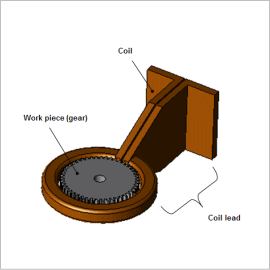
Gears are created in such a way that the surfaces of their teeth are hard in order to resist the wear and tear that occurs when they come into contact with the teeth of other gears. However, this has to be accomplished while maintaining the gear’s overall toughness. In the case of high-frequency induction heating, which is one of the surface hardening methods, just the surface of the teeth can be hardened by rapidly heating only the surface using a high-frequency power source. This process also has many other benefits, such as providing a clean working environment because it uses electrical equipment, being very efficient, and providing uniform results for each product. This is why it is being aggressively implemented in the field. On the other hand, there are several factors that need to be studied in order to heat the gear’s surface uniformly, such as how to adjust the heating coil’s geometry, arrangement, current frequency and size.
The eddy currents generated by high-frequency varying magnetic fields are uneven in the tooth surface, so the material properties change a great deal as the temperature rises. In order to handle the detailed phenomena, it is necessary to calculate the heat generation amount in a numerical analysis based on the finite element method (FEM).
This Application Note shows how to create a numerical analysis model when obtaining the optimum coil geometry and current conditions (power supply frequency and current value), analyze the elevated temperature process, and evaluate whether or not the model fulfills the target temperature distribution.
The eddy currents generated by high-frequency varying magnetic fields are uneven in the tooth surface, so the material properties change a great deal as the temperature rises. In order to handle the detailed phenomena, it is necessary to calculate the heat generation amount in a numerical analysis based on the finite element method (FEM).
This Application Note shows how to create a numerical analysis model when obtaining the optimum coil geometry and current conditions (power supply frequency and current value), analyze the elevated temperature process, and evaluate whether or not the model fulfills the target temperature distribution.
Eddy Current Loss Density Distribution of the Gear
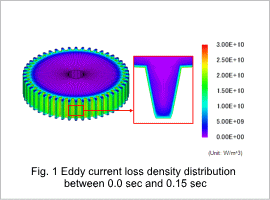
Fig. 1 shows the eddy current loss density distribution of the surface of the gear and the cross-section of a tooth top. Each cross-section shown in the figure is at the midway position of the tooth width. The magnetic field generated by the coil produces eddy currents on the gear tooth surface. This eddy currents are distributed on the surface of the gear due to the skin effect.
Temperature Distribution and Variation of the Gear
Fig. 2 shows the temperature distribution of the gear, and fig. 3 shows the temperature variation versus time of the tooth tops. Fig. 3 shows the temperature variation of the tooth top at the measuring points shown in fig. 2. From the temperature distribution, it is apparent that the eddy currents generate heat in the tooth top.
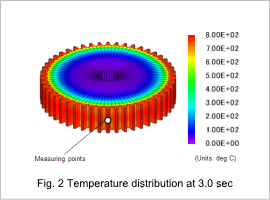
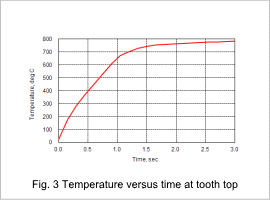
Maximum Achieving Temperature Distribution
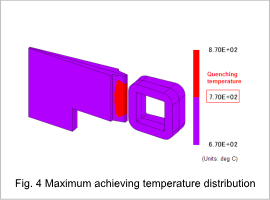
Fig. 4 shows the maximum temperature that each part reaches. This figure is a two color contour plot, where the parts exceeding 770 deg C are shown in red, and those below 770 deg C are shown in purple.


